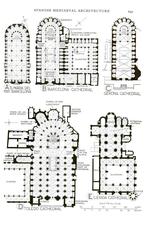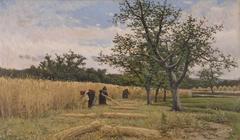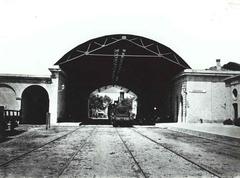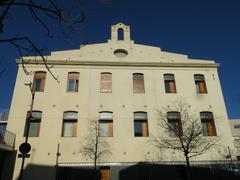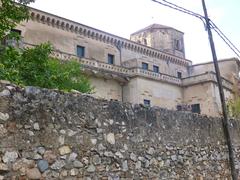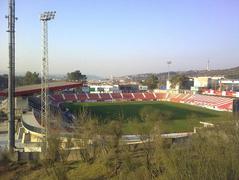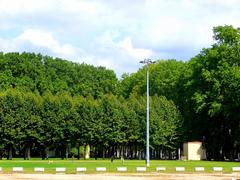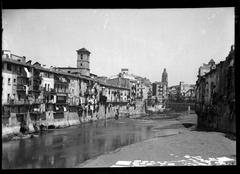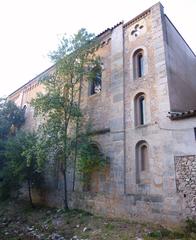Visiting Pont de Sant Feliu in Girona: History, Tickets, and Tips
Date: 01/08/2024
Introduction
Nestled in the picturesque city of Girona, Spain, the Pont de Sant Feliu stands as a striking example of modern engineering harmoniously blended with historical charm. Constructed in 1998, this pedestrian bridge connects Devesa Park with Saint Feliu Square, offering a crucial link for residents and tourists alike. Designed by the renowned engineering firm PEDELTA, the bridge features a minimalist aesthetic enhanced by its weathering steel frame, which develops a rustic patina over time (Wikipedia). This guide delves into the history, architectural significance, and practical visiting tips for those eager to explore this contemporary landmark within Girona’s rich historical tapestry.
Girona, a city famed for its well-preserved medieval architecture and vibrant cultural scene, provides an idyllic backdrop for the Pont de Sant Feliu. The bridge not only facilitates pedestrian movement but also offers panoramic views of the Onyar River and the stunning Gothic and Baroque structures that define the cityscape. Recognized with awards such as the Civil Engineering Mention Award at the Construmat Exhibition in 2000, the bridge is celebrated for its innovative design and engineering excellence (Visita Costa Brava). Whether you’re an architecture enthusiast, a history buff, or simply a traveler seeking scenic vistas, visiting the Pont de Sant Feliu promises a blend of visual delight and cultural enrichment.
Table of Contents
- Construction and Design
- Awards and Recognition
- Construction Process
- Integration with Urban Landscape
- Cultural Significance
- Visitor Experience
- Visitor Information
- Maintenance and Preservation
- Frequently Asked Questions (FAQ)
- Conclusion
- References
Construction and Design
The Pont de Sant Feliu, also known as the Sant Feliu Pedestrian Bridge, was constructed in 1998. This bridge was designed to connect Devesa Park with Saint Feliu Square, providing a crucial pedestrian link between these two significant areas in Girona. The bridge’s design was undertaken by PEDELTA, a firm known for its minimalist and functional approach to civil engineering projects. The main span of the bridge measures 58.4 meters, and it features a weathering steel frame with a single span, embedded on both ends into concrete abutments.
The bridge’s deck is 3.5 meters wide, and it is characterized by a weathering steel box girder of variable height, ranging from 0.6 meters at the middle span to 1.7 meters at the supports. The steel handrail is an integral part of the main structure, contributing to the bridge’s sleek and minimalist aesthetic. The use of weathering steel, which develops a stable rust-like appearance over time, was a deliberate choice to ensure that the bridge would blend harmoniously with its urban surroundings.
Awards and Recognition
The Pont de Sant Feliu has received several accolades for its design and construction. In 2000, it was awarded the Civil Engineering Mention Award (2nd Prize) at the Construmat Exhibition. Additionally, the bridge was selected for the FAD Awards in 1997 and the Eduardo Torroja Awards in 1999. These recognitions highlight the bridge’s innovative design and its significance in the field of civil engineering.
Construction Process
The construction of the Pont de Sant Feliu involved several meticulous steps to ensure the integrity and durability of the structure. The steel girder was prefabricated in three segments, which were then lifted into their final position using two auxiliary supports. Once the segments were in place, they were welded together to form a continuous span. The concrete abutments were cast in place thereafter, completing the final structure. This method of construction ensured that the bridge was both robust and aesthetically pleasing.
Integration with Urban Landscape
The Pont de Sant Feliu is strategically located in the old district of Girona, an area known for its strong historical and cultural significance. The bridge serves as a vital link between the old town and the more modern areas of the city, facilitating pedestrian movement and enhancing the overall connectivity of Girona. The minimalist design of the bridge ensures that it does not overshadow the historical architecture of the surrounding area, but rather complements it.
Cultural Significance
The Pont de Sant Feliu is more than just a functional piece of infrastructure; it is a symbol of the harmonious blend between the old and the new in Girona. The bridge offers pedestrians a wider, almost flat, wooden walkway, providing easy access to the old town area with a welcoming view of the St. Felix Church. The choice of materials and the design of the bridge reflect a sensitivity to the historical context of the area, while also embracing modern engineering techniques.
Visitor Experience
For visitors, the Pont de Sant Feliu offers a unique vantage point to appreciate the beauty of Girona. The bridge provides stunning views of the Onyar River and the surrounding architecture, making it a popular spot for photography. The weathering steel frame, with its rust-like appearance, adds a touch of rustic charm to the bridge, making it a picturesque location for tourists.
Visitor Information
Visiting Hours and Tickets
The Pont de Sant Feliu is open to pedestrians 24/7, and there is no admission fee to cross the bridge. This makes it an accessible and cost-effective way to explore the stunning views and historical significance of the area.
Travel Tips
- Best Time to Visit: Early morning or late afternoon for optimal light for photography.
- Nearby Attractions: Devesa Park, Saint Feliu Square, and the St. Felix Church.
- Accessibility: The bridge is designed to accommodate pedestrians of all abilities, with a flat deck making it easy for wheelchairs and strollers.
Special Events and Guided Tours
Occasionally, the city organizes guided tours that include the Pont de Sant Feliu as part of the itinerary. These tours often delve into the historical and engineering aspects of the bridge, providing a more in-depth understanding of its significance.
Maintenance and Preservation
Given its exposure to the elements, the Pont de Sant Feliu requires regular maintenance to ensure its longevity. The weathering steel, while designed to develop a stable rust-like appearance, still needs to be monitored for any signs of structural weakness. The concrete abutments and the steel handrails also require periodic inspections to ensure that they remain in good condition. The city of Girona has taken steps to ensure that the bridge is well-maintained, preserving its structural integrity and aesthetic appeal for future generations.
Frequently Asked Questions (FAQ)
Q: What are the visiting hours for Pont de Sant Feliu?
A: The Pont de Sant Feliu is open to pedestrians 24/7.
Q: Is the Pont de Sant Feliu accessible for people with disabilities?
A: Yes, the bridge features a flat deck that is accessible for wheelchairs and strollers.
Q: Are there guided tours available?
A: Yes, guided tours that include the Pont de Sant Feliu are occasionally organized by the city.
Q: What are some nearby attractions?
A: Nearby attractions include Devesa Park, Saint Feliu Square, and the St. Felix Church.
Conclusion
The Pont de Sant Feliu stands as a testament to the successful integration of modern engineering with historical sensitivity. Its minimalist design, combined with its functional significance, makes it a vital part of Girona’s urban landscape. The bridge not only facilitates pedestrian movement but also enhances the cultural and aesthetic appeal of the city. For visitors, it offers a unique opportunity to experience the beauty of Girona from a different perspective, making it a must-visit location in the city.
